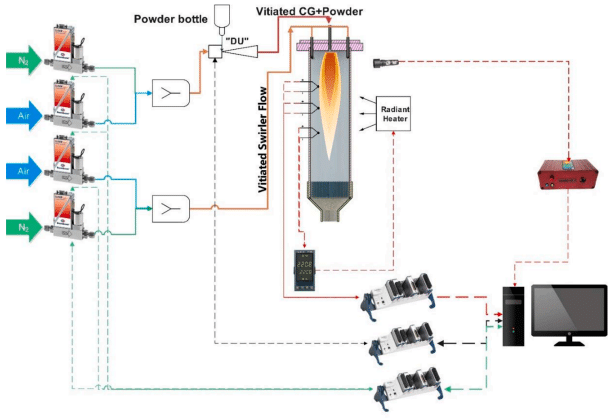Mohammadreza Baigmohammadi, Willie Prasidha, Nicole C. Stevens, Yuri L. Shoshyn, Tim Spee, Philip de Goey
Published: 13 January 2023 | Power & Flow Group, Department of Mechanical Engineering, Eindhoven University of Technology (TU/e)

Abstract
In the present study, a novel and initiative approach towards a self-sustainable metal combustion burner called the “Metal Cyclonic Combustor (MC2)” is introduced. The results show that a self–sustained iron flame can be established inside the MC2 under normal air conditions (21% O2), and even at very low oxygen concentrations (~10% O2) and for low overall equivalence ratios (~ 0.2), without any assisting extra heat sources. However, the results demonstrate that a proper preheating level corresponding to the oxygen concentration can still guarantee flame stability even in lower oxygen concentrations as low as 5%. Moreover, it was shown that the iron particles’ temperature reduced significantly after switching to a combustion regime with low oxygen concentrations. This finding is significant in mitigating the partial evaporation of metal particles and circumventing nano-particle formation and related mass losses. Furthermore, some physicochemical complex phenomena and critical challenges (e.g. particle burning temperature, emissions, recyclability, etc.) that govern the optimal performance of metal combustion systems are recognized and discussed. It is believed that the results of this study may be of significant importance to lead us towards designing fully industrial and novel practical metal combustors/ burners as a significant step forward towards developing high–energy density, zero-carbon, zero-emission (HEDZ) combustion-based systems needed for transition to carbon-free energy systems.
… Also, the particles’ burning temperature was evaluated by their thermal radiation measured using StellarNet DWARF–Star NIR spectrometer with wavelength range 850 nm–1700 nm. The spectrometer was calibrated using a certified tungsten ribbon lamp, with a piece of quartz tube installed between the light source and the collimator of the spectrometer to mimic the translucence effect of the quartz tube for insitu measurement …





